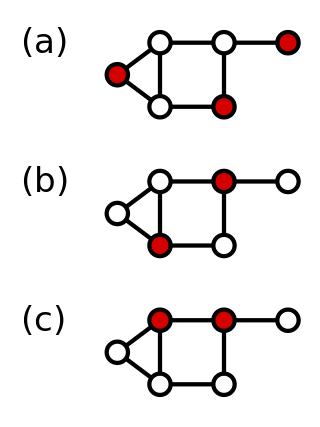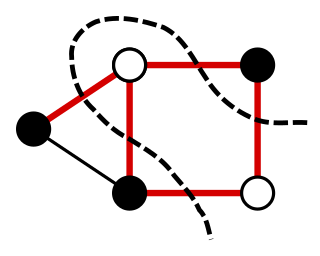Related Research Articles

In computational complexity theory, NP-hardness is the defining property of a class of problems that are informally "at least as hard as the hardest problems in NP". A simple example of an NP-hard problem is the subset sum problem.

In computer science, the time complexity is the computational complexity that describes the amount of computer time it takes to run an algorithm. Time complexity is commonly estimated by counting the number of elementary operations performed by the algorithm, supposing that each elementary operation takes a fixed amount of time to perform. Thus, the amount of time taken and the number of elementary operations performed by the algorithm are taken to be related by a constant factor.

Combinatorial optimization is a subfield of mathematical optimization that consists of finding an optimal object from a finite set of objects, where the set of feasible solutions is discrete or can be reduced to a discrete set. Typical combinatorial optimization problems are the travelling salesman problem ("TSP"), the minimum spanning tree problem ("MST"), and the knapsack problem. In many such problems, such as the ones previously mentioned, exhaustive search is not tractable, and so specialized algorithms that quickly rule out large parts of the search space or approximation algorithms must be resorted to instead.

In combinatorial mathematics, the Steiner tree problem, or minimum Steiner tree problem, named after Jakob Steiner, is an umbrella term for a class of problems in combinatorial optimization. While Steiner tree problems may be formulated in a number of settings, they all require an optimal interconnect for a given set of objects and a predefined objective function. One well-known variant, which is often used synonymously with the term Steiner tree problem, is the Steiner tree problem in graphs. Given an undirected graph with non-negative edge weights and a subset of vertices, usually referred to as terminals, the Steiner tree problem in graphs requires a tree of minimum weight that contains all terminals. Further well-known variants are the Euclidean Steiner tree problem and the rectilinear minimum Steiner tree problem.
In computer science and operations research, approximation algorithms are efficient algorithms that find approximate solutions to optimization problems with provable guarantees on the distance of the returned solution to the optimal one. Approximation algorithms naturally arise in the field of theoretical computer science as a consequence of the widely believed P ≠ NP conjecture. Under this conjecture, a wide class of optimization problems cannot be solved exactly in polynomial time. The field of approximation algorithms, therefore, tries to understand how closely it is possible to approximate optimal solutions to such problems in polynomial time. In an overwhelming majority of the cases, the guarantee of such algorithms is a multiplicative one expressed as an approximation ratio or approximation factor i.e., the optimal solution is always guaranteed to be within a (predetermined) multiplicative factor of the returned solution. However, there are also many approximation algorithms that provide an additive guarantee on the quality of the returned solution. A notable example of an approximation algorithm that provides both is the classic approximation algorithm of Lenstra, Shmoys and Tardos for scheduling on unrelated parallel machines.
In computer science, parameterized complexity is a branch of computational complexity theory that focuses on classifying computational problems according to their inherent difficulty with respect to multiple parameters of the input or output. The complexity of a problem is then measured as a function of those parameters. This allows the classification of NP-hard problems on a finer scale than in the classical setting, where the complexity of a problem is only measured as a function of the number of bits in the input. The first systematic work on parameterized complexity was done by Downey & Fellows (1999).

In graph theory, a dominating set for a graph G is a subset D of its vertices, such that any vertex of G is either in D, or has a neighbor in D. The domination numberγ(G) is the number of vertices in a smallest dominating set for G.
In computational complexity theory, the class APX is the set of NP optimization problems that allow polynomial-time approximation algorithms with approximation ratio bounded by a constant. In simple terms, problems in this class have efficient algorithms that can find an answer within some fixed multiplicative factor of the optimal answer.
A fully polynomial-time approximation scheme (FPTAS) is an algorithm for finding approximate solutions to function problems, especially optimization problems. An FPTAS takes as input an instance of the problem and a parameter ε > 0. It returns as output a value is at least times the correct value, and at most times the correct value.
MAX-3SAT is a problem in the computational complexity subfield of computer science. It generalises the Boolean satisfiability problem (SAT) which is a decision problem considered in complexity theory. It is defined as:
Uniform machine scheduling is an optimization problem in computer science and operations research. It is a variant of optimal job scheduling. We are given n jobs J1, J2, ..., Jn of varying processing times, which need to be scheduled on m different machines. The goal is to minimize the makespan - the total time required to execute the schedule. The time that machine i needs in order to process job j is denoted by pi,j. In the general case, the times pi,j are unrelated, and any matrix of positive processing times is possible. In the specific variant called uniform machine scheduling, some machines are uniformly faster than others. This means that, for each machine i, there is a speed factor si, and the run-time of job j on machine i is pi,j = pj / si.
In computational complexity, strong NP-completeness is a property of computational problems that is a special case of NP-completeness. A general computational problem may have numerical parameters. For example, the input to the bin packing problem is a list of objects of specific sizes and a size for the bins that must contain the objects—these object sizes and bin size are numerical parameters.
In computational complexity theory, a PTAS reduction is an approximation-preserving reduction that is often used to perform reductions between solutions to optimization problems. It preserves the property that a problem has a polynomial time approximation scheme (PTAS) and is used to define completeness for certain classes of optimization problems such as APX. Notationally, if there is a PTAS reduction from a problem A to a problem B, we write .

For a graph, a maximum cut is a cut whose size is at least the size of any other cut. That is, it is a partition of the graph's vertices into two complementary sets S and T, such that the number of edges between S and T is as large as possible. Finding such a cut is known as the max-cut problem.
In computational complexity theory, the set splitting problem is the following decision problem: given a family F of subsets of a finite set S, decide whether there exists a partition of S into two subsets S1, S2 such that all elements of F are split by this partition, i.e., none of the elements of F is completely in S1 or S2. Set Splitting is one of Garey & Johnson's classical NP-complete problems. The problem is sometimes called hypergraph 2-colorability.
In computability theory and computational complexity theory, especially the study of approximation algorithms, an approximation-preserving reduction is an algorithm for transforming one optimization problem into another problem, such that the distance of solutions from optimal is preserved to some degree. Approximation-preserving reductions are a subset of more general reductions in complexity theory; the difference is that approximation-preserving reductions usually make statements on approximation problems or optimization problems, as opposed to decision problems.
In computer science and operations research, exact algorithms are algorithms that always solve an optimization problem to optimality.
The multiple subset sum problem is an optimization problem in computer science and operations research. It is a generalization of the subset sum problem. The input to the problem is a multiset of n integers and a positive integer m representing the number of subsets. The goal is to construct, from the input integers, some m subsets. The problem has several variants:
Identical-machines scheduling is an optimization problem in computer science and operations research. We are given n jobs J1, J2, ..., Jn of varying processing times, which need to be scheduled on m identical machines, such that a certain objective function is optimized, for example, the makespan is minimized.
A parameterized approximation algorithm is a type of algorithm that aims to find approximate solutions to NP-hard optimization problems in polynomial time in the input size and a function of a specific parameter. These algorithms are designed to combine the best aspects of both traditional approximation algorithms and fixed-parameter tractability.
References
- ↑ Sanjeev Arora, Polynomial-time Approximation Schemes for Euclidean TSP and other Geometric Problems, Journal of the ACM 45(5) 753–782, 1998.
- 1 2 Jansen, Thomas (1998), "Introduction to the Theory of Complexity and Approximation Algorithms", in Mayr, Ernst W.; Prömel, Hans Jürgen; Steger, Angelika (eds.), Lectures on Proof Verification and Approximation Algorithms, Springer, pp. 5–28, doi:10.1007/BFb0053011, ISBN 9783540642015 . See discussion following Definition 1.30 on p. 20.
- ↑ Vazirani, Vijay V. (2003). Approximation Algorithms. Berlin: Springer. pp. 294–295. ISBN 3-540-65367-8.